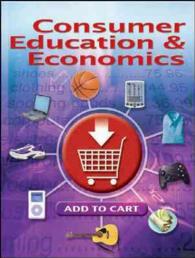- ホーム
- > 洋書
- > 英文書
- > Science / Mathematics
Full Description
Were you looking for the book with access to MyStatLab? This product is the book alone and does NOT come with access to MyStatLab. Buy the book and access card package to save money on this resource.For a one- or two-semester course in business statistics. Statistics for Business and Economics, Twelfth Edition, meets today's business students with a balance of clarity and rigor, and applications incorporated from a diverse range of industries. This classic text covers a wide variety of data collection and analysis techniques with these goals in mind: developing statistical thinking, learning to assess the credibility and value of inferences made from data, and making informed business decisions.The Twelfth Edition has been updated with real, current data in many of the exercises, examples, and applications. Exercises draw on actual business situations and recent economic events so that students can test their knowledge throughout the course. Statistics in Action case studies open each chapter with a recent, controversial, or high-profile business issue, motivating students to critically evaluate the findings and think through the statistical issues involved. A continued emphasis on ethics highlights the importance of ethical behavior in collecting, interpreting, and reporting on data.
Contents
1. Statistics, Data, and Statistical Thinking1.1 The Science of Statistics1.2 Types of Statistical Applications in Business1.3 Fundamental Elements of Statistics1.4 Processes (Optional)1.5 Types of Data1.6 Collecting Data: Sampling and Related Issues1.7 Critical Thinking with StatisticsStatistics in Action: A 20/20 View of Surveys: Fact or Fiction?Activity 1.1: Keep the Change: Collecting DataActivity 2.2: Identifying Misleading StatisticsUsing Technology: Accessing and Listing Data; Random Sampling2. Methods for Describing Sets of Data2.1 Describing Qualitative Data2.2 Graphical Methods for Describing Quantitative Data2.3 Numerical Measures of Central Tendency2.4 Numerical Measures of Variability2.5 Using the Mean and Standard Deviation to Describe Data2.6 Numerical Measures of Relative Standing2.7 Methods for Detecting Outliers: Box Plots and z-Scores2.8 Graphing Bivariate Relationships (Optional)2.9 The Time Series Plot (Optional)2.10 Distorting the Truth with Descriptive TechniquesStatistics in Action: Can Money Buy Love?Activity 2.1: Real Estate SalesActivity 2.2: Keep the Change: Measures of Central Tendency and VariabilityUsing Technology: Describing DataMaking Business Decisions: The Kentucky Milk CasePart 1 (Covers Chapters 1 and 2)3. Probability3.1 Events, Sample Spaces, and Probability3.2 Unions and Intersections3.3 Complementary Events3.4 The Additive Rule and Mutually Exclusive Events3.5 Conditional Probability3.6 The Multiplicative Rule and Independent Events3.7 Bayes's RuleStatistics in Action: Lotto Buster!Activity 3.1: Exit Polls: Conditional ProbabilityActivity 3.2: Keep the Change: Independent EventsUsing Technology: Combinations and Permutations4. Random Variables and Probability Distributions4.1 Two Types of Random VariablesPART I: Discrete Random Variables4.2 Probability Distributions for Discrete Random Variables4.3 The Binomial Distribution4.4 Other Discrete Distributions: Poisson and HypergeometricPART II: Continuous Random Variables4.5 Probability Distributions for Continuous Random Variables4.6 The Normal Distribution4.7 Descriptive Methods for Assessing Normality4.8 Other Continuous Distributions: Uniform and ExponentialStatistics in Action: Probability in a Reverse Cocaine Sting: Was Cocaine Really Sold?Activity 4.1: Warehouse Club Memberships: Exploring a Binomial Random VariableActivity 4.2: Identifying the Type of Probability DistributionUsing Technology: Discrete Probabilities, Continuous Probabilities, and Normal Probability Plots5. Sampling Distributions5.1 The Concept of a Sampling Distribution5.2 Properties of Sampling Distributions: Unbiasedness and Minimum Variance5.3 The Sampling Distribution of the Sample Mean and the Central Limit Theorem5.4 The Sampling Distribution of the Sample ProportionStatistics in Action: The Insomnia Pill: Is It Effective?Activity 5.1: Simulating a Sampling DistributionCell Phone UsageUsing Technology: Simulating a Sampling DistributionMaking Business Decisions: The Furniture Fire Case (Covers Chapters 3-5)6. Inferences Based on a Single Sample: Estimation with Confidence Intervals6.1 Identifying and Estimating the Target Parameter6.2 Confidence Interval for a Population Mean: Normal (z) Statistic6.3 Confidence Interval for a Population Mean: Student's t-Statistic6.4 Large-Sample Confidence Interval for a Population Proportion6.5 Determining the Sample Size6.6 Finite Population Correction for Simple Random Sampling (Optional)6.7 Confidence Interval for a Population Variance (Optional)Inferences Based on a Single Sample: Estimation with Confidence IntervalsStatistics in Action: Medicare Fraud InvestigationsActivity 6.1: Conducting a Pilot StudyUsing Technology: Confidence Intervals7. Inferences Based on a Single Sample: Tests of Hypotheses7.1 The Elements of a Test of Hypothesis7.2 Formulating Hypotheses and Setting Up the Rejection Region7.3 Observed Significance Levels: p-Values7.4 Test of Hypothesis about a Population Mean: Normal (z) Statistic7.5 Test of Hypothesis about a Population Mean: Student's t-Statistic7.6 Large-Sample Test of Hypothesis about a Population Proportion7.7 Test of Hypothesis about a Population Variance7.8 Calculating Type II Error Probabilities: More about b (Optional)Statistics in Action: Diary of a Kleenex (R) User-How Many Tissues in a Box?Activity 7.1: Challenging a Company's Claim: Tests of HypothesesActivity 7.2: Keep the Change: Tests of HypothesesUsing Technology: Tests of Hypotheses8. Inferences Based on Two Samples: Confidence Intervals and Tests of Hypotheses8.1 Identifying the Target Parameter8.2 Comparing Two Population Means: Independent Sampling8.3 Comparing Two Population Means: Paired Difference Experiments8.4 Comparing Two Population Proportions: Independent Sampling8.5 Determining the Required Sample Size8.6 Comparing Two Population Variances: Independent SamplingStatistics in Action: ZixIt Corp. v. Visa USA Inc.-A Libel CaseActivity 8.1: Box Office Receipts: Comparing Population MeansActivity 8.2: Keep the Change: Inferences Based on Two SamplesUsing Technology: Two-Sample InferencesMaking Business Decisions: The Kentucky Milk Case-Part II (Covers Chapters 6-8)9. Design of Experiments and Analysis of Variance9.1 Elements of a Designed Experiment9.2 The Completely Randomized Design: Single Factor9.3 Multiple Comparisons of Means9.4 The Randomized Block Design9.5 Factorial Experiments: Two FactorsStatistics in Action: Pollutants at a Housing Development-A Case of Mishandling Small SamplesActivity 9.1: Designed vs. Observational ExperimentsUsing Technology: Analysis of Variance10. Categorical Data Analysis10.1 Categorical Data and the Multinomial Experiment10.2 Testing Category Probabilities: One-Way Table10.3 Testing Category Probabilities: Two-Way (Contingency) Table10.4 A Word of Caution about Chi-Square TestsStatistics in Action: The Case of the Ghoulish Transplant Tissue-Who Is Responsible for Paying Damages?Activity 10.1: Binomial vs. Multinomial ExperimentsActivity 10.2: Contingency TablesUsing Technology: Chi-Square AnalysesMaking Business Decisions: Discrimination in the Workplace (Covers Chapters 9 and 10)11. Simple Linear Regression11.1 Probabilistic Models11.2 Fitting the Model: The Least Squares Approach11.3 Model Assumptions11.4 Assessing the Utility of the Model: Making Inferences about the Slope b111.5 The Coefficients of Correlation and Determination11.6 Using the Model for Estimation and Prediction11.7 A Complete ExampleStatistics in Action: Legal Advertising-Does It Pay?Activity 11.1: Apply Simple Linear Regression to Your Favorite DataUsing Technology: Simple Linear Regression12. Multiple Regression and Model Building12.1 Multiple Regression ModelsPART I: First-Order Models with Quantitative Independent Variables12.2 Estimating and Making Inferences about the b Parameters12.3 Evaluating Overall Model Utility12.4 Using the Model for Estimation and PredictionPART II: Model Building in Multiple Regression12.5 Interaction Models12.6 Quadratic and Other Higher-Order Models12.7 Qualitative (Dummy) Variable Models12.8 Models with Both Quantitative and Qualitative Variables12.9 Comparing Nested Models12.10 Stepwise RegressionPART III: Multiple Regression Diagnostics12.11 Residual Analysis: Checking the Regression Assumptions12.12 Some Pitfalls: Estimability, Multicollinearity, and ExtrapolationStatistics in Action: Bid Rigging in the Highway Construction IndustryActivity 12.1: Insurance Premiums: Collecting Data for Several VariablesActivity 12.2: Collecting Data and Fitting a Multiple Regression ModelUsing Technology: Multiple RegressionMaking Business Decisions: The Condo Sales Case (Covers Chapters 11 and 12)13. Methods for Quality Improvement: Statistical Process Control (Available on CD)13.1 Quality, Processes, and Systems13.2 Statistical Control13.3 The Logic of Control Charts13.4 A Control Chart for Monitoring the Mean of a Process: The [x-bar]-Chart 13.5 A Control Chart for Monitoring the Variation of a Process: The R-Chart13.6 A Control Chart for Monitoring the Proportion of Defectives Generated by a Process: The p-Chart13.7 Diagnosing the Causes of Variation13.8 Capability AnalysisStatistics in Action: Testing Jet Fuel Additive for SafetyActivity 13.1: Quality Control: ConsistencyUsing Technology: Control ChartsMAKING BUSINESS DECISIONS: The Gasket Manufacturing Case (Covers Chapter 13)14. Time Series: Descriptive Analyses, Models, and Forecasting (Available on CD)14.1 Descriptive Analysis: Index Numbers14.2 Descriptive Analysis: Exponential Smoothing14.3 Time Series Components14.4 Forecasting: Exponential Smoothing14.5 Forecasting Trends: Holt's Method14.6 Measuring Forecast Accuracy: MAD and RMSE14.7 Forecasting Trends: Simple Linear Regression14.8 Seasonal Regression Models14.9 Autocorrelation and the Durbin-Watson TestStatistics in Action: Forecasting the Monthly Sales of a New Cold MedicineActivity 14.1: Time SeriesUsing Technology: Forecasting15. Nonparametric Statistics (Available on CD)15.1 Introduction: Distribution-Free Tests15.2 Single Population Inferences15.3 Comparing Two Populations: Independent Samples15.4 Comparing Two Populations: Paired Difference Experiment15.5 Comparing Three or More Populations: Completely Randomized Design15.6 Comparing Three or More Populations: Randomized Block Design15.7 Rank CorrelationStatistics in Action: How Vulnerable Are New Hampshire Wells to Groundwater Contamination?Activity 15.1: Keep the Change: Nonparametric StatisticsUsing Technology: Nonparametric TestsMaking Business Decisions: Detecting "Sales Chasing" (Covers Chapters 10 and 15)Answers to Selected ExercisesIndexCredits








